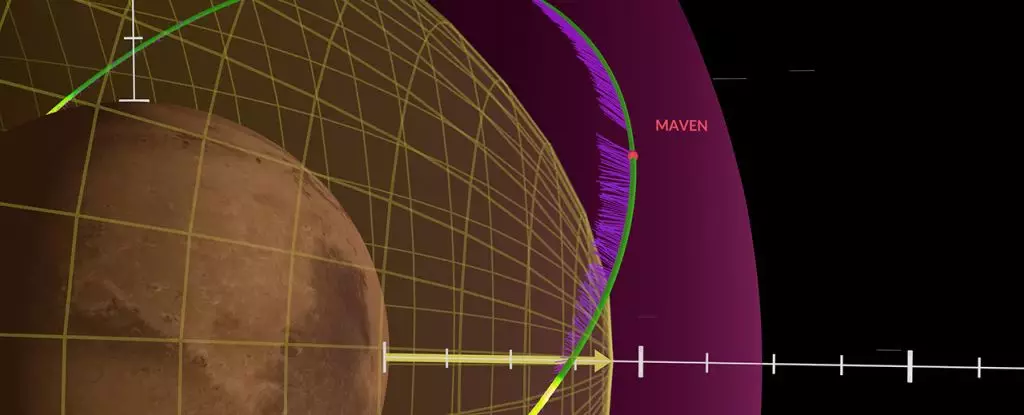The atmosphere of Mars experienced a remarkable event on 26 December 2022 when a powerful gust of solar wind caused it to expand dramatically. This unprecedented incident occurred as the MAVEN spacecraft, orbiting Mars, detected a sudden drop in solar particles alongside a peculiar transformation in the Martian atmosphere. The magnetosphere and ionosphere of the planet expanded by thousands of kilometers, more than tripling their size. The last time such a phenomenon was observed was in 1999 when Earth’s magnetosphere significantly swelled due to a similar decrease in the solar wind. This rare occurrence provides valuable insights into how Mars and other planets interact with their surroundings, shedding light on the behavior of Solar System-like planets around different types of stars.
This extraordinary event highlights the importance of placing spacecraft in orbit around various celestial bodies in our Solar System. By directly witnessing the effects of sudden changes in solar conditions, scientists gain crucial knowledge about the behavior of planets. Astronomer Jasper Halekas, the lead author of a new study on the event, expressed his astonishment at the data collected. The findings unearthed during this time period have proven extremely informative, contributing to our understanding of planetary dynamics.
Solar wind, a steady stream of particles emitted by the Sun, permeates the Solar System. All planets reside within this stream, which creates ambient pressure that weakens with distance and eventually subsides at the heliopause. Although the solar wind remains relatively constant, its strength can fluctuate due to solar activity. For instance, areas of reduced solar magnetic fields on the Sun’s surface can generate a more intense solar wind, bombarding the entire system with stronger and more abundant solar particles.
On 26 December 2022, Mars experienced a distinctive solar wind event. This event involved the convergence of two solar winds, with a slower wind being absorbed by a faster wind approaching from behind, resulting in a unified and more forceful solar wind. The MAVEN spacecraft identified the higher particle density of this merged solar wind. However, when the gust passed, the spacecraft observed a significant drop in particle density, creating an extraordinary void of weak and low-density solar wind. The pressure exerted by the solar wind also decreased by a factor of 10, while the density reduced by a factor of 100.
In response to the drop in pressure, the Martian atmosphere underwent notable changes. Normally, the solar wind pushes against a planet’s magnetosphere, which is predominantly generated by the internal movements of molten materials on Earth. Mars lacks a global magnetosphere; however, it possesses an induced magnetic field formed by the entanglement of magnetic fields in the solar wind with Mars’ ionosphere. As a consequence of the solar wind’s effects, the ionosphere and induced magnetic field expanded significantly, causing Mars’ atmosphere to metaphorically loosen its corset. The induced magnetic field became unmagnetized, and the area between it and the solar wind, known as the bow shock, became much calmer than usual. The researchers anticipate that this phenomenon will provide valuable insights into atmospheric loss processes on Mars and similar planets throughout the galaxy, contributing to the overall understanding of habitability.
The newfound understanding of Mars’ response to the removal of solar wind presents a unique opportunity for studying the planet’s behavior under unusual circumstances. Jasper Halekas highlights the relevance of this outlier study, as it offers glimpses into what Mars could be like if it orbited a star with less intense solar wind activity. These insights contribute to the ongoing investigation of habitable conditions on other planets, helping scientists identify the crucial factors that determine a planet’s potential for hosting life.
The unforeseen expansion of Mars’ atmosphere in reaction to a powerful gust of solar wind puzzled scientists and provided a remarkable opportunity for investigating the behavior of planets in response to changes in their environments. This intriguing event emphasizes the significance of in situ measurements and highlights the value of placing spacecraft in orbit around various celestial bodies in our Solar System. The data obtained during this event contributes to our understanding of Mars and other Solar System-like planets, shedding light on the complex interaction between planetary atmospheres and their surrounding environments.


Leave a Reply